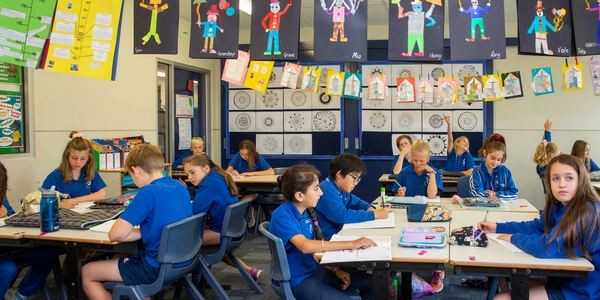School Curriculum
Fulham North Primary Schools Curriculum is guided by the Australian Curriculum. It is designed to develop successful learners, confident and creative individuals striving for personal achievement.
To view information for parents on the Australian Curriculum please click on each year level.
Foundation Year 1 & 2 Year 3 & 4 Year 5 & 6 Year 7 & 8
ENGLISH
Students focus on reading, writing and oral skills.
Junior Primary – Students follow a phonetic letter program focusing on letter sounds and blending them to make words. Fine motor skills to produce proper pencil grip and letter formation for writing and regular sharing time to build confidence sharing with their peers. By the end of year two reading with fluency and expression, ability to write persuasive texts, growing accuracy with spelling strategies, punctuation and using grammar features when writing.
Middle Primary – Students read independently displaying comprehension of content and ability to respond critically, accurately research, plan, prepare and write different text types with attention to punctuation, grammar and spelling. Students speak confidently, listen and ask appropriate questions.
Upper Primary – Students study and produce narratives, persuasive texts, speeches and poetry. They produce procedures, reviews and information reports. Develop skills in grammar, punctuation and reading comprehension. Study written texts for research purposes and present information in a variety of ways.
Students are tested and reviewed regularly to ensure they are supported if needed and to extend their learning to ensure personal achievement.
MATHS
Focuses on number workings and mathematical enquiry and problem solving skills.
Junior Primary starting with learning numbers 1-10 and shape identification, patterns and sorting, identifying different ways of measuring and recognising mathematical symbols. By the end of year 2 students have an understanding of money, fractions chance and data, count to and from 1000, recognise sequencing involving 2, 5 and 10’s, identifying missing elements in number sequences, understanding place value, solve simple addition and attraction problems. They use a range of written and mental strategies and are able to collect, check and classify data.
Middle Primary starts with basic addition and subtraction mentally as well as multiplication and division facts of 2, 3, 5 and 10. Working with operations up to 10 000, constructing 3D shapes, identifying symmetry, telling time, creating and interpreting grid maps, identifying angles and measuring and comparing objects using measures of length, mass and capacity. By the end of year 5 students are demonstrating problem solving skills in various assessments to demonstrate their understanding of division, order of operations, operations with fractions, chance and data, position and direction, geometry, transformation of 2D shapes and volume and mass and measurement of time, length and area.
Upper Primary Students cover measurement, geometry, fractions, decimals, percentages, patterns, algebra, chance, data location and transformations, volume, capacity, problem solving and working mathematically.
Students are tested and reviewed regularly to ensure they are supported if needed and to extend their learning to ensure personal achievement.
SCIENCE
Junior Primary & Middle Primary Students learn about Biological, Chemical, Physical and Earth & Space Sciences. Each year building and extending their knowledge further into each topic.
Biological Science -learning about the needs of people, animals and plants. Analysing how the form of living things enables them to function in their environment.
Chemical Science – investigating objects made of materials that have observerable qualities. Identifying those that can be recycled and the process.
Physical Science -Students investigate how light, chemicals, sound and forces are produced by a range of forces. Students use contact and non-contact forces to describe interactions between objects.
Earth and Space Sciences – Learning about how the Earth rotates on its axis causing regular changes including night and day. Investigating how natural and human processes cause changes to the Earth’s surface.
Upper Primary Cover Chemical Sciences through solutions and Mixtures and Biological Sciences through classification of animals. Students study Newton’s Three Laws of Motion.
HUMANITIES AND SOCIAL SCIENCES
Humanities and Social Sciences covers 4 subject areas:
Geography – Students study locations of major geographical divisions of the world, explore the places they live, Australian States and Territories developing an understanding of natural and manmade features and studying indigenous people of Australia and the world.
History – various topics some including – Understanding past present and future, looking at commemorative events/Days in Australia and the world and the importance to their families and investigating European settlement in Australia.
Civics and Citizenship (years 3-7) – Understanding the significance of making decisions democratically; rights and responsibilities with a focus on who makes the rules and why they are important. Students develop knowledge and understanding of the role of local government and distinguish between rules and laws. Investigating the three levels of government in Australia and explore the functionality of local councils and investigating who can be an Australian citizen, formal rights, responsibilities and shared values.
Economics and Business (Years 5-7) – preparing simple budgets and learning terminology, study economic decision making, budgeting and entrepreneurial choices.
To view our 3 Specialist Learning Areas please click the subjects






